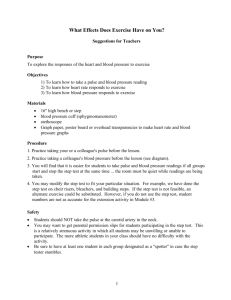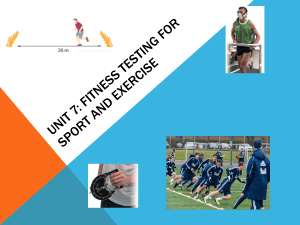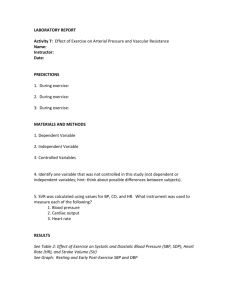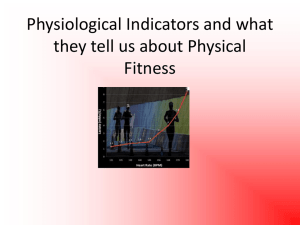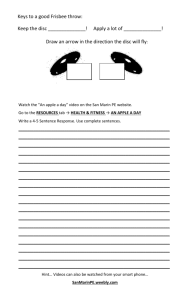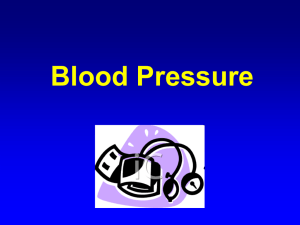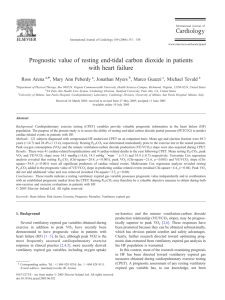Kinesiology Name________________________________
advertisement
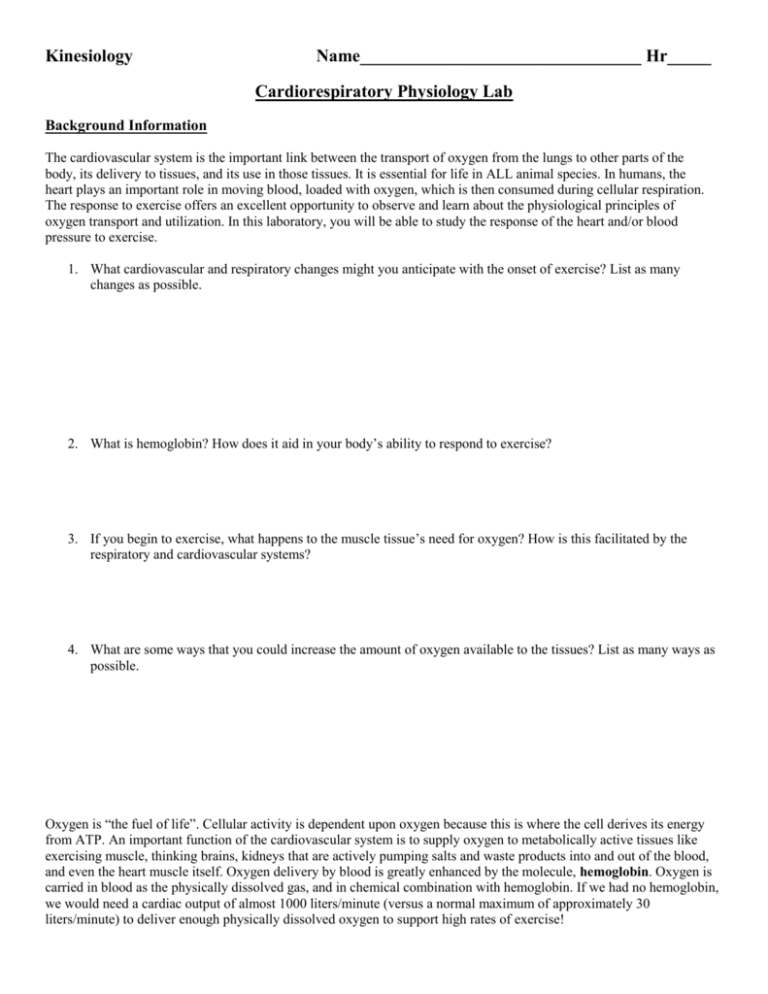
Kinesiology Name________________________________ Hr_____ Cardiorespiratory Physiology Lab Background Information The cardiovascular system is the important link between the transport of oxygen from the lungs to other parts of the body, its delivery to tissues, and its use in those tissues. It is essential for life in ALL animal species. In humans, the heart plays an important role in moving blood, loaded with oxygen, which is then consumed during cellular respiration. The response to exercise offers an excellent opportunity to observe and learn about the physiological principles of oxygen transport and utilization. In this laboratory, you will be able to study the response of the heart and/or blood pressure to exercise. 1. What cardiovascular and respiratory changes might you anticipate with the onset of exercise? List as many changes as possible. 2. What is hemoglobin? How does it aid in your body’s ability to respond to exercise? 3. If you begin to exercise, what happens to the muscle tissue’s need for oxygen? How is this facilitated by the respiratory and cardiovascular systems? 4. What are some ways that you could increase the amount of oxygen available to the tissues? List as many ways as possible. Oxygen is “the fuel of life”. Cellular activity is dependent upon oxygen because this is where the cell derives its energy from ATP. An important function of the cardiovascular system is to supply oxygen to metabolically active tissues like exercising muscle, thinking brains, kidneys that are actively pumping salts and waste products into and out of the blood, and even the heart muscle itself. Oxygen delivery by blood is greatly enhanced by the molecule, hemoglobin. Oxygen is carried in blood as the physically dissolved gas, and in chemical combination with hemoglobin. If we had no hemoglobin, we would need a cardiac output of almost 1000 liters/minute (versus a normal maximum of approximately 30 liters/minute) to deliver enough physically dissolved oxygen to support high rates of exercise! If we want to know how much oxygen is being used by the tissues, we can measure the concentration of oxygen in the artery and in the vein and calculate the difference. 5. What variable is being described above? This will tell us the difference in concentration but will not tell us the amount of oxygen being taken in and used by the tissue (oxygen uptake). 6. What other information might we need to determine oxygen uptake? What variable measures oxygen uptake? Cardiorespiratory function can be measured in a number of different ways. Each of the variables we have discussed in class will respond to exercise in some way. 7. Make predictions regarding how each of the following variables will respond to exercise. Complete the “Definition” and “Prediction” columns only. Variable Blood flow to skeletal muscle Cardiac output Heart rate Stroke volume Systolic pressure in the arteries Diastolic pressure in the arteries Mean Arterial Pressure Definition Prediction Actual Procedure 1. With your partner, take turns measuring resting heart rates. The “subject” should stand quietly at rest for 2 minutes before you measure his/her pulse. 2. Your partner should find your radial pulse (on the thumb side of the inner wrist) and count it for each of the times directed below. Then use the multiplication factor to calculate the number of beats per minute. [Note: If you have difficulty finding the pulse, try the other wrist] Count pulse for: Record the count Multiply by: 60 seconds X1 30 seconds X2 15 seconds X4 10 seconds X6 6 seconds X 10 Heart beats per minute 3. Next, measure your respiratory rate by placing your hand on your chest and counting the number breaths taken in 60 seconds. Record your resting respiratory rate in the space below. Resting Respiration Rate (breaths/min): _________________ 4. While you are still standing, measure your blood pressure using the digital wrist cuff. Follow the provided directions for use of the digital blood pressure cuff. Record in the space below. Blood Pressure: ______________________ 5. Calculate your Mean Arterial Pressure (MAP) using the following equation: Mean Arterial Pressure = Diastolic Pressure + 1/3(Systolic Pressure-Diastolic Pressure) MAP = ____________________________ 6. Add your resting data to the data table below. Measurements Taken: At rest Post-exercise Heart rate from BP Cuff ( ) Systolic Pressure ( ) Diastolic Pressure ( ) Mean arterial pressure ( ) Respiratory Rate ( ) Now you are ready to perform the same measures under exercise conditions. You will perform the Physical Fitness Step Test which will allow you to determine the effect of exercise on each of our measured variables. This test will also be used to predict your VO2 max. 7. Using the benches in the North Commons you will step up and down at a pre-determined pace. A metronome will be set at 88 beats/minute for females & 96 beats/minute for males. The step test will last 3 minutes and should be performed in a cadence of “up-up-down-down”. While performing the step test you will wear one of the digital blood pressure cuffs. 8. After the step test is complete, the subject should remain standing and do the following: a. Initiate the digital blood pressure cuff. b. The exerciser should count their post-exercise respiratory rate using the method described on the previous page. c. Record your post-exercise heart rate, blood pressure & respiratory rate in the data table on the previous page. 9. Calculate the Mean Arterial Pressure after exercising using the same formula as used during resting measures. Record in the data table above. 10. Calculate your estimated VO2 max using the appropriate equation below. Remember to use the appropriate units!!! Men VO2 max (ml/kg/min) = 111.33 - (0.42 x heart rate beats/min) Women VO2 max (ml/kg/min) = 65.81 - (0.1847 x heart rate beats/min) VO2 max = _____________________________ 11. Return to the table on page 1 of the lab where you made your original predictions. Now, based on your observations, collected data and calculations, complete the “Actual” column of the table. Analysis Questions 1. What happens to the resting heart rate depending upon how long you take your measurements? Why could you get different answers for different measurement times? 2. A wide range of “normal” or healthy resting heart rates exist depending on many different individual factors. What might be some explanations for the variability in heart rate between individuals? 3. What is cardiac output? What is it dependent upon? 4. If a normal cardiac output is 5 liters/minute at rest, use your resting heart rate to calculate your stroke volume. Show your work in the space below and circle your answer. 5. What happens to heart rate when you exercise? Why do you think it is important for this to occur? 6. Divide your post-exercise heart rate by your resting heart rate. How many times faster was your heart beating after exercise? 7. Since stroke volume remains relatively constant during exercise, calculate your cardiac output after exercise. Show your work in the space below and circle your answer. 8. What happens to the Mean Arterial Pressure when you exercise? Why do you think it is important for this to occur? 9. What happened to the systolic pressure when you exercised? Use your data to justify your answer. 10. What happened to the diastolic pressure when you exercised? Use your data to justify your answer. 11. How might you explain the difference between your systolic and diastolic response to exercise? 12. Look at your estimated VO2 max. How much total oxygen were you using per minute? [Hint: You will need to convert your body weight into kilograms! 1 lb = .45 kg] 13. A normal resting oxygen consumption is 250 ml O2/min. Assuming you are normal, how many folds did your oxygen uptake increase from rest to after exercise? Show your work in the space below. 14. Analyze the graph by extrapolating the data. What will this individual’s oxygen consumption be at: a. b. c. d. 500 W? ______________________ 600 W? ______________________ 700 W? ______________________ What conclusions can you draw regarding the body’s ability to perform oxygen uptake? 15. In a well-developed paragraph, respond to the following: What implications does this learning have for your understanding of the body’s utilization of various energy systems? [i.e. What connections can you make to our last unit of study?]
